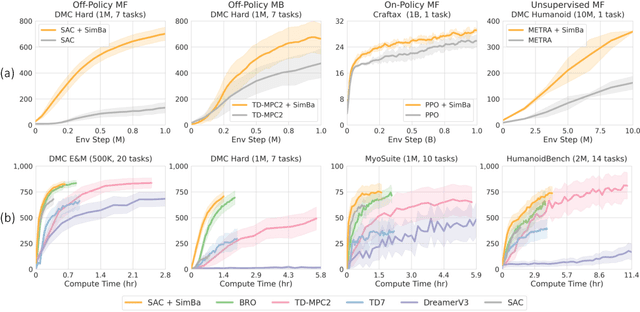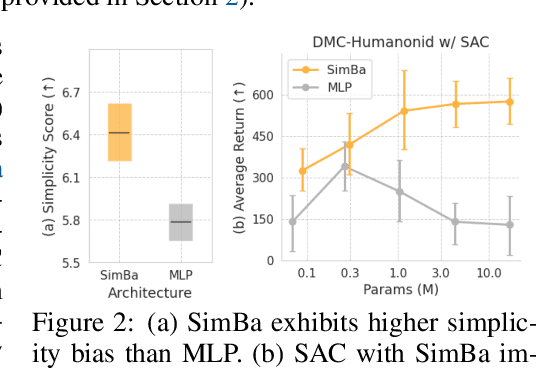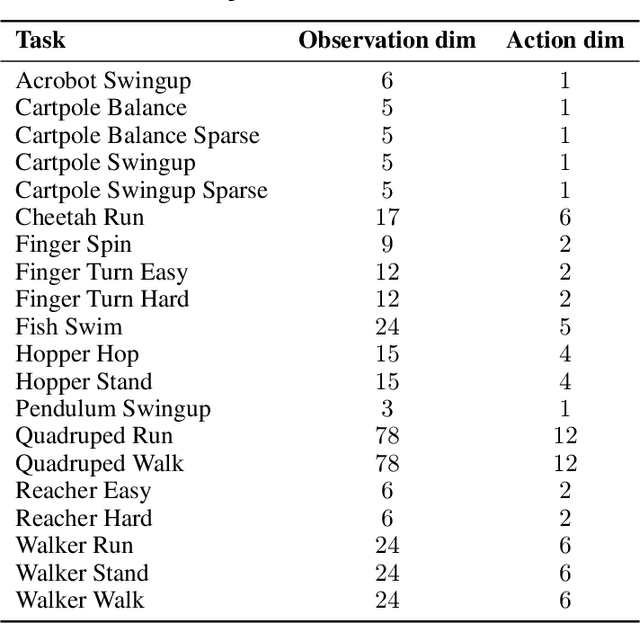Kaushik Subramanian
SimBa: Simplicity Bias for Scaling Up Parameters in Deep Reinforcement Learning
Oct 13, 2024



Abstract:Recent advances in CV and NLP have been largely driven by scaling up the number of network parameters, despite traditional theories suggesting that larger networks are prone to overfitting. These large networks avoid overfitting by integrating components that induce a simplicity bias, guiding models toward simple and generalizable solutions. However, in deep RL, designing and scaling up networks have been less explored. Motivated by this opportunity, we present SimBa, an architecture designed to scale up parameters in deep RL by injecting a simplicity bias. SimBa consists of three components: (i) an observation normalization layer that standardizes inputs with running statistics, (ii) a residual feedforward block to provide a linear pathway from the input to output, and (iii) a layer normalization to control feature magnitudes. By scaling up parameters with SimBa, the sample efficiency of various deep RL algorithms-including off-policy, on-policy, and unsupervised methods-is consistently improved. Moreover, solely by integrating SimBa architecture into SAC, it matches or surpasses state-of-the-art deep RL methods with high computational efficiency across DMC, MyoSuite, and HumanoidBench. These results demonstrate SimBa's broad applicability and effectiveness across diverse RL algorithms and environments.
A Super-human Vision-based Reinforcement Learning Agent for Autonomous Racing in Gran Turismo
Jun 18, 2024



Abstract:Racing autonomous cars faster than the best human drivers has been a longstanding grand challenge for the fields of Artificial Intelligence and robotics. Recently, an end-to-end deep reinforcement learning agent met this challenge in a high-fidelity racing simulator, Gran Turismo. However, this agent relied on global features that require instrumentation external to the car. This paper introduces, to the best of our knowledge, the first super-human car racing agent whose sensor input is purely local to the car, namely pixels from an ego-centric camera view and quantities that can be sensed from on-board the car, such as the car's velocity. By leveraging global features only at training time, the learned agent is able to outperform the best human drivers in time trial (one car on the track at a time) races using only local input features. The resulting agent is evaluated in Gran Turismo 7 on multiple tracks and cars. Detailed ablation experiments demonstrate the agent's strong reliance on visual inputs, making it the first vision-based super-human car racing agent.
Navigating Occluded Intersections with Autonomous Vehicles using Deep Reinforcement Learning
Feb 27, 2018



Abstract:Providing an efficient strategy to navigate safely through unsignaled intersections is a difficult task that requires determining the intent of other drivers. We explore the effectiveness of Deep Reinforcement Learning to handle intersection problems. Using recent advances in Deep RL, we are able to learn policies that surpass the performance of a commonly-used heuristic approach in several metrics including task completion time and goal success rate and have limited ability to generalize. We then explore a system's ability to learn active sensing behaviors to enable navigating safely in the case of occlusions. Our analysis, provides insight into the intersection handling problem, the solutions learned by the network point out several shortcomings of current rule-based methods, and the failures of our current deep reinforcement learning system point to future research directions.
 Add to Chrome
Add to Chrome Add to Firefox
Add to Firefox Add to Edge
Add to Edge